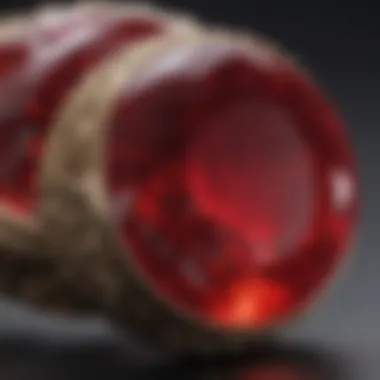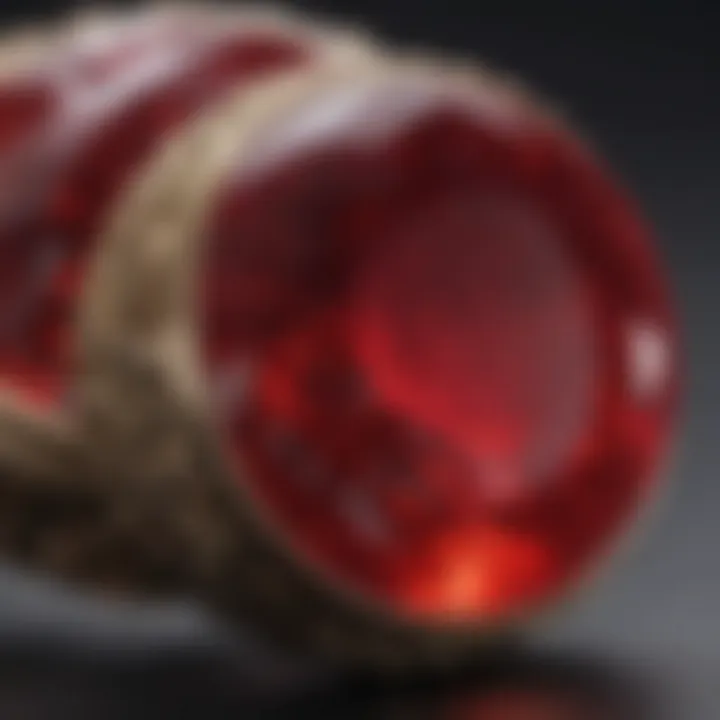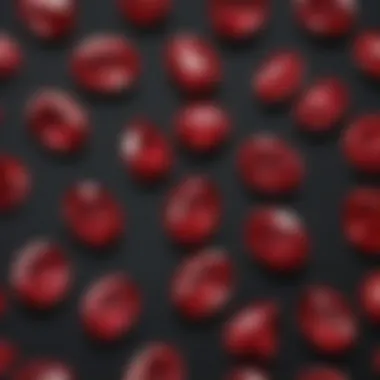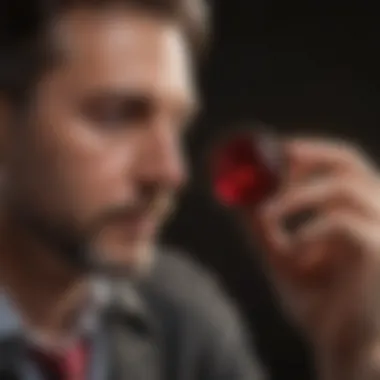Understanding the Price of Pigeon Blood Ruby


Intro
Pigeon blood ruby is one of the most coveted gemstones in the world. Understanding its price involves looking deeply into multiple aspects that influence its valuation. From its unique color to market demand, each factor plays a crucial role in setting the price. This section aims to provide a brief insight into the elements that will be discussed throughout the article, enriching the reader’s knowledge.
Gemstone Overview
Definition and Characteristics
Pigeon blood rubies are a variety of corundum, specifically known for their vivid red hue. The name "pigeon blood" refers to a particular shade that resembles the blood of a freshly killed pigeon, recognized for its depth and luminosity. The ideal pigeon blood ruby exhibits a rich, intense red with minimal darkness and excellent clarity. This depth of color comes from the presence of chromium, making each stone distinctive.
Classification of Gemstones
Gemstones are classified based on their physical properties, rarity, and cultural significance. Pigeon blood rubies fall within the precious gemstone category, alongside diamonds, emeralds, and sapphires. Within this category, they are classified further based on their color, clarity, and origin, which can greatly impact their market value.
Historical Significance
Ancient Uses and Cultural Importance
Throughout history, rubies have been highly regarded in various cultures. In ancient India and Myanmar, rubies were believed to possess spiritual powers. They were often used in royal adornments and were regarded as symbols of power and prosperity. The historical significance adds to their desirability in today’s market.
Myths and Legends Surrounding Gemstones
Legends often surround the origins of these stones. Many cultures have claimed that wearing ruby can bring good fortune and protection. In some stories, rubies were said to hold the power to heal wounds and protect the wearer from evil spirits. These fables contribute to the mystical aura that pigeon blood rubies carry.
Understanding the historical context can enhance value appreciation.
Overall, the pricing of pigeon blood rubies is influenced by a multitude of factors, including market dynamics, historical significance, and grading criteria, which will be explored further in the subsequent sections.
Prolusion to Pigeon Blood Ruby
Pigeon blood ruby, often considered one of the most coveted gemstones, has significant value not just as a piece of jewelry but also as an investment. This ruby variety is renowned for its rich red hue and is prized by jewelers and collectors alike. Each stone is unique in its characteristics, making it essential for enthusiasts to understand its particularities.
The importance of understanding pigeon blood ruby lies in its rarity and the factors that influence its price. These stones originate mainly from Myanmar, where their deep red color is influenced by specific geological conditions. Knowing the source of these gemstones can significantly affect their market value. Furthermore, the color intensity, clarity, and other attributes are vital aspects that contribute to the valuation process.
By exploring the peculiarities of pigeon blood ruby, buyers can make informed choices. Collectors need to be aware of grading systems that assess quality and authenticity. This knowledge ensures that consumers do not overpay for inferior products or fall victim to counterfeit stones. Additionally, understanding historical context lends depth to the significance of these gemstones, offering insights into their lasting appeal and investment potential.
Moreover, market trends reveal how supply and demand dynamics impact pricing. Potential buyers should stay updated with current market prices to make sound investments. In this article, we will delve deeply into the characteristics of pigeon blood ruby, historical context, market trends, and practical purchasing guidelines. By the end, readers will gain a comprehensive understanding of not only what pigeon blood rubies are but also how to appreciate their true value.
Characteristics of Pigeon Blood Ruby
The characteristics of pigeon blood ruby are paramount in understanding its value. Each gem possesses unique qualities that impact desirability and market price. These attributes—color, clarity, transparency, cut, and carat weight—are closely examined by collectors, gemologists, and investors alike. Proper appreciation of these factors can significantly influence buying decisions and investment outcomes.
Color and Its Significance
Color is often viewed as the most critical aspect of pigeon blood ruby. The term "pigeon blood" refers to a vivid red hue with slight blue undertones. This particular shade is highly coveted and determines the stone’s appeal in the eyes of collectors and buyers.
An ideal pigeon blood ruby achieves a balance in saturation and tone, resulting in a deep color that can be perceived from a distance. GIA, among other grading systems, uses color as a fundamental grading criterion. Higher quality stones exhibit a pure red without visible secondary hues, while less-quality stones may display brown or orange overtones, diminishing their value.
Clarity and Transparency
Clarity refers to the absence of inclusions and blemishes within the ruby. Pigeon blood rubies with high clarity are rare and therefore command premium prices. A stone that is transparent allows light to pass through it effectively, enhancing its brilliance.


Even minor inclusions can impact a stone's beauty and value. Flawless stones are often considered collector's items, while those with visible inclusions might be appreciated for their uniqueness but valued less. Additionally, transparency plays a role; stones that exhibit a glass-like quality tend to attract higher prices.
Cut and Carat Weight
The cut of a pigeon blood ruby affects how it interacts with light, influencing its overall brilliance and aesthetics. A well-cut ruby will exhibit fiery flashes of light and depth of color, while poor cutting can make even the finest stones seem dull. The traditional oval or cushion cuts are popular, as they maximize the color and brilliance of the stone.
Carat weight is another determinant of value. Larger stones naturally are rarer and more valuable. However, the price-per-carat often decreases as carat weight increases beyond certain thresholds. For instance, a well-cut 1 carat pigeon blood ruby may be valued higher per carat than a 5 carat stone if the latter lacks the finest color and clarity.
In summary, all these characteristics work together to define the price and desirability of pigeon blood rubies. Each element should be carefully considered when purchasing a ruby to ensure that the investment is sound and meets the purchaser's standards.
Historical Context of Pigeon Blood Ruby
Understanding the historical context of pigeon blood ruby is key to grasping its current market value and appeal. Through centuries, these gemstones have captured the hearts of many cultures, often associated with power, wealth, and status. This significance offers valuable insights into why such rubies continue to demand high prices today. The historical narratives linked to this precious stone enrich its overall cultural relevance, affecting both its desirability and valuation in the modern market.
Ancient Cultures and Their Appreciation
Pigeon blood rubies have long been revered across various ancient cultures. In regions such as Asia, particularly in Myanmar, rubies were not just decorative items, but symbols of authority and legendary status. The vibrant and deep red hue was likened to the blood of pigeons, hence the name, which amplified its worth in local metaphysics and rituals.
For instance, the Burmese believed that rubies could grant invincibility to its wearer. Such entrenched belief systems contributed to the rise in demand and the importance placed on the stone. Furthermore, the gemstones were often featured in royal regalia, further cementing their status as a cornerstone of wealth and power among aristocracy.
- Ancient texts and accounts often highlight the royal burials adorned with these radiant stones.
- Many emperors and kings collected pigeon blood rubies as part of their treasures, enhancing their legacy through the beauty of these natural wonders.
The Evolution of Ruby Valuation
Over the centuries, the methods of valuing rubies, especially pigeon blood variety, have undergone significant transformations. What was once a simple assessment based on color and size has evolved into a more intricate procedure involving grading systems and market analysis.
In earlier times, the absence of formal grading mechanisms meant that valuations were often subjective. Traders and jewelers relied heavily on personal experience and cultural trends to determine a ruby's worth. With time, internationally recognized grading systems emerged. These systems consider various factors such as color saturation, clarity, and cut, making the valuation process more standardized.
Currently, organizations like the Gemological Institute of America (GIA) provide comprehensive grading reports that further influence market pricing. Each ruby is graded on a scale that factors in the intensity of its color, which is critical to determining its overall market value. Additionally, the rise of globalization has allowed for wider visibility and accessibility to these gemstones, further impacting their valuation.
Thus, understanding the market evolution offers insights into both historical appreciation and current pricing dynamics, making it essential for anyone engaging in the purchase or evaluation of pigeon blood rubies.
Market Trends for Pigeon Blood Ruby
Understanding the market trends for pigeon blood rubies is essential for both collectors and investors. These trends indicate how the pricing evolves, alongside external factors influencing demand and availability. Analyzing the current market allows potential buyers to make informed decisions when investing in these high-value gemstones.
Current Market Prices
Currently, the price of pigeon blood rubies is indicative of their rarity and quality. Market prices can fluctuate significantly based on various aspects such as size, color saturation, and clarity. As of now, top-grade pigeon blood rubies can fetch prices that range from several thousand to hundreds of thousands of dollars per carat.
Seasonal demand also plays a role. For instance, during peak buying seasons like holidays or major trade shows, prices may see a sharp increase. Additionally, prices can be influenced by economic conditions, where consumers tend to invest in luxury items during economic stability.
"The price of pigeon blood rubies isn't just about size; it's a complex blend of quality, sourcing, and market conditions that drive its valuation."
Supply and Demand Dynamics
Supply and demand dynamics greatly affect the pricing of pigeon blood rubies. The sources of these gemstones are limited, primarily found in Myanmar, which adds to their allure and scarcity. Political instability in mining regions can also lead to fluctuations in availability, consequently impacting prices.
On the demand side, a growing interest from collectors and investors has been observed. The increase in awareness of these gems' unique properties has further influenced consumer behavior. Those in the jewelry industry also seek these stones for high-end designs, contributing to their market demand.
Investment Potential in Pigeon Blood Ruby
Investing in pigeon blood rubies carries significant potential. As a precious gemstone, they not only offer aesthetic value but also a potential for appreciation over time. The rarity and cultural significance of these stones add layers to their investment appeal.


Investors should consider the long-term value trajectory of pigeon blood rubies. Over the past years, investment-grade rubies have shown resilience and stability in pricing. Moreover, factors such as certification from well-known grading institutions, like the Gemological Institute of America, can enhance their marketability and resale value.
In summary, understanding current prices, supply and demand, and investment potential is crucial for navigating the market of pigeon blood rubies. Each aspect influences how collectors and investors approach their acquisitions and whether they will find success in this elite segment.
Factors Affecting Price of Pigeon Blood Ruby
Geological Sources
The geological origins of pigeon blood rubies are fundamental to their pricing. Rubies sourced from Burma (Myanmar) often command higher prices due to their legendary quality and historical significance. Apart from Burma, countries like Thailand and Tanzania also produce rubies, though these may not match the elite status of Burmese stones. The soil composition, heat and pressure conditions at the time of formation all affect the ultimate quality of the gem.
Factors such as the clarity, color saturation, and overall aesthetics of the stones directly relate to their source. Pigeon blood rubies generally have a unique "red" that is slightly tinged with a hint of blue, a characteristic often attributed to their Burmese origin. Thus, geological sources not only influence the ruby’s quality but also shape market perception and pricing.
Certification and Grading Systems
Certification is another critical element in the valuation of pigeon blood rubies. Institutions such as the Gemological Institute of America (GIA) provide grading services that assess gems based on established criteria. Without certification, consumers may find it difficult to trust the quality and authenticity of a ruby, leading to lower valuations.
Grading encompasses several attributes, including color, clarity, cut, and carat weight. Those rubies that earn the highest grades inevitably fetch more in the market. Collectors often look for certifications to avoid counterfeit stones, elevating the certified specimens’ demand. Thus, the presence or absence of credible grading can significantly alter a ruby's price.
Market Perception and Branding
Market perception serves as an influential factor affecting ruby prices as well. Branding plays a unique role in this perception. Some famous jewelers and brands have cultivated an image that enhances the desirability and prestige of pigeon blood rubies. Consequently, a ruby sold under a renowned name often costs more than a similarly graded one from an unknown source.
Buyers often associate certain characteristics with specific brands, leading to increased willingness to pay for branded stones. The impact of marketing and brand storytelling cannot be underestimated, as they shape consumer expectations and value perceptions. This makes understanding the branding elements crucial for anyone looking to enter the market for pigeon blood rubies.
"The sourcing, grading, and branding of pigeon blood rubies intertwine, weaving a complex tapestry of value and desire in the gem marketplace."
In summary, the price of pigeon blood rubies is informed by their geological sources, grading systems, and how the market perceives their value. Understanding these facets can help buyers and collectors navigate the often murky waters of gemstone pricing.
Buying Guide for Pigeon Blood Ruby
Buying a pigeon blood ruby is not just a purchase; it is an investment in beauty and history. This segment aims to equip prospective buyers with essential insights into making informed decisions. Understanding the intricacies of this gemstone can greatly enhance the buying experience and prevent costly mistakes. It is crucial to focus on particular elements such as authenticity, quality attributes, and reputable purchasing venues. These factors not only influence the financial value but also the long-term satisfaction of owning such a unique gem.
Identifying Authenticity
Before proceeding with any purchase, verifying the authenticity of a pigeon blood ruby is paramount. This variety of ruby is known for its vivid red color, which can sometimes be imitated by synthetic or lesser quality stones. Here are a few key indicators to consider:
- Certification: Always request a certification from a reputable gemological laboratory, such as the Gemological Institute of America (GIA). These certificates provide detailed information about the stone’s origin and its characteristics.
- Visual Inspection: Observe the stone closely under natural light. Authentic pigeon blood rubies tend to display an intense red hue, sometimes with slight fluorescence.
- Inclusions: Look for natural inclusions. Authentic stones often have some imperfections, whereas synthetic rubies are usually flawless.
"A certified gemstone is not just a piece of jewelry; it is a guarantee of quality and authenticity."
Evaluating Quality Attributes
When evaluating pigeon blood rubies, consider several quality attributes that affect both beauty and price:
- Color: The depth and purity of the red color are critical. High-quality pigeon blood rubies exhibit a pure red hue without an overtone of purple or brown.
- Clarity: Some inclusions can enhance a ruby's character. However, the fewer the inclusions, especially visible ones, the better the clarity rating.
- Cut: The stone's cut influences its brilliance. A well-cut ruby will reflect light beautifully, enhancing its visual appeal.
- Carat Weight: Larger rubies are rarer and thus command higher prices. However, quality should not be ignored for size alone.
Where to Purchase
Finding the right place to purchase a pigeon blood ruby can be challenging. It is recommended to consider the following options:
- Reputable Jewelers: Established jewelers often provide quality gemstones along with necessary certifications.
- Gem Shows: Attending gem and mineral shows can give buyers access to multiple sellers and a chance to see various stones in person.
- Online Platforms: Websites such as Etsy or specialized gemstone marketplaces can offer a range of options. Always verify seller ratings and read reviews.
- Auctions: Premium auction houses occasionally feature high-quality rubies, which can be a good place to find unique pieces.
By focusing on these key aspects, buyers can approach their purchase with greater assurance, ultimately enhancing their collection of pigeon blood rubies.


Caring for Pigeon Blood Ruby
Caring for pigeon blood ruby is vital for maintaining the gemstone's allure and value. This section emphasizes the significance of proper care to prevent damage or degradation over time. A well-cared ruby not only retains its beauty but can also enhance its resale value. Collectors and enthusiasts need to be informed about the appropriate methods of cleaning and storing these precious stones to ensure that they continue to captivate.
Cleaning Techniques
Cleaning pigeon blood rubies should be approached with caution. Using the wrong methods can lead to scratches or dulling of the stone's surface. Here are some effective techniques:
- Use Mild Soaps: A gentle dish soap mixed with warm water is effective. Avoid anything abrasive.
- Soft Cloth: Always use a soft, lint-free cloth for drying. This helps eliminate any water spots without scratching the stone.
- Avoid Ultrasonic Cleaners: These devices are generally too harsh for delicate stones like pigeon blood ruby.
- No Harsh Chemicals: Stay away from bleach or ammonia, as they can cause damage.
Regular cleaning ensures that the ruby remains vibrant and clear, showcasing its captivating red hue. This is essential for maintaining its visual appeal.
Storage Recommendations
Storing pigeon blood rubies properly is crucial for protecting them from potential scratches and environmental damage. Consider these storage tips:
- Soft Pouches: Keep the ruby in a soft pouch to minimize exposure to dust and scratches.
- Separate Compartments: If possible, store rubies in separate compartments within a jewelry box. This prevents them from coming into contact with other gemstones that may be harder and could cause scratches.
- Controlled Environment: Avoid extreme temperatures and humidity. A stable environment helps preserve the integrity of the stone.
- Regular Inspection: Periodically check your rubies to monitor for any signs of damage. This is an opportunity to act quickly if something is wrong.
By adopting these simple yet effective care measures, collectors, jewelry designers, and enthusiasts can significantly prolong the life and beauty of their prized pigeon blood rubies.
Future Outlook for Pigeon Blood Ruby Market
The future outlook for the pigeon blood ruby market is a vital aspect to consider for gemstone enthusiasts, collectors, and investors. Understanding the upcoming trends can provide insights into the stability and potential growth of this rare gemstone. It influences not only current market decisions but also shapes long-term investment strategies. With the increasing global interest in colored gemstones, particularly those with unique qualities such as pigeon blood rubies, stakeholders should remain informed about market dynamics, pricing forecasts, and emerging challenges that might arise.
Predicted Market Trends
As the demand for pigeon blood rubies continues to rise, several key trends may emerge in the market. First, we should expect an increase in consumer awareness regarding the significance of color and quality. The pivot towards exquisite coloration means that collectors and jewelry designers may prioritize pigeo blood rubies over other types. In addition, technological advancements in mining and grading are likely to improve the availability of high-quality stones in various markets. This may also influence the transparency of pricing structures and the presentation of these gemstones.
Second, sustainability and ethical sourcing will remain critical. Buyers are increasingly seeking gemstones that are verified for ethical extraction. This trend could lead to premium pricing for responsibly sourced pigeon blood rubies, as consumers gravitate towards options that align with their values.
Finally, the interaction of economic factors—such as inflation and global economic shifts—could influence the market as well. If the economy performs well, the demand for luxury goods like pigeon blood rubies may increase, pushing prices upward. Conversely, a downturn could restrict spending on collectibles.
Potential Risks and Challenges
As we analyze the future, there are several potential risks and challenges that could affect the market for pigeon blood rubies. One major concern is market saturation. Should an influx of similar-quality stones enter the market due to new mining developments, there might be downward pressure on prices.
Additionally, the complexities of grading and certification could remain a barrier. While standardized grading systems aim to bring clarity, discrepancies in assessments can lead to confusion and mistrust among buyers. It is crucial for consumers to be well-informed to make educated purchases.
Finally, geopolitical issues can also play a role. Pigeon blood rubies are primarily sourced from specific regions, such as Myanmar. Political instability in these areas may disrupt the supply chain, influencing availability and market costs.
"Understanding market trends is essential for making informed decisions about investments in pigeon blood rubies. Navigating risks effectively can result in greater returns."
End
The conclusion serves as a critical element in this article, drawing together key insights about the valuation of pigeon blood rubies. Through understanding the complexities surrounding their pricing, one can appreciate several important aspects that come into play.
First, recognizing the rarity and unique characteristics of pigeon blood rubies is essential. These gemstones possess distinct color qualities, clarity standards, and cut characteristics that significantly influence their market value. Therefore, buyers should equip themselves with this knowledge, ensuring they make informed decisions when acquiring these exquisite gems.
Second, the historical significance of these rubies connects the present market to past appreciation. Awareness of how ancient cultures valued these stones can deepen one’s personal connections with the gems. This historical context reinforces the notion that market trends are often informed by cultural significance and demand.
Third, the future outlook for the pigeon blood ruby market illustrates potential investment risks and rewards. As market dynamics shift, understanding these challenges is paramount. Buyers, particularly collectors and investors, must remain vigilant and adaptable to ensure long-term satisfaction and value retention.
Lastly, the act of caring for and maintaining pigeon blood rubies cannot be overlooked. Proper cleaning and storage techniques help preserve the beauty of these gemstones, adding to their lifecycle value.
In summary, the conclusion encapsulates the various dimensions discussed throughout the article. It emphasizes that a thorough understanding of price determinants, historical insights, and market trends is vital for anyone serious about investing in or appreciating pigeon blood rubies. Being an informed buyer not only enhances personal enjoyment but also ensures wise financial choices in the vibrant world of gemstone trading.
"Knowledge is the first step towards acquisition in the competitive gemstone market."
By synthesizing information presented in the previous sections, one can navigate the complexities of the pigeon blood ruby market with greater confidence and insight.







